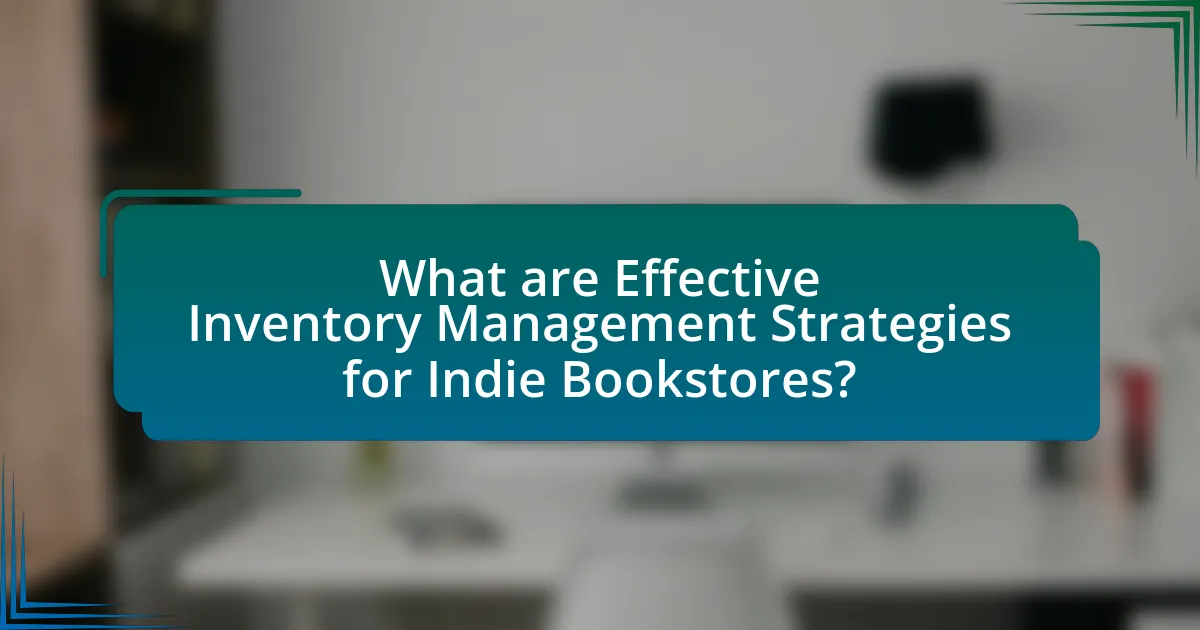Effective inventory management strategies are crucial for the success of indie bookstores, focusing on optimizing stock levels and enhancing customer satisfaction. Key strategies include implementing robust point-of-sale systems, utilizing data analytics for demand forecasting, and fostering strong relationships with publishers. The article explores the challenges indie bookstores face, such as limited financial resources and competition from larger retailers, while highlighting the importance of tailored inventory strategies that align with local customer preferences. Additionally, it discusses the role of technology and data analysis in improving inventory decision-making, as well as best practices for maintaining optimal stock levels and avoiding common pitfalls.

What are Effective Inventory Management Strategies for Indie Bookstores?
Effective inventory management strategies for indie bookstores include implementing a robust point-of-sale system, utilizing data analytics for demand forecasting, and establishing relationships with publishers for better stock management. A point-of-sale system helps track sales in real-time, allowing bookstores to identify bestsellers and slow-moving items. Data analytics can predict customer preferences and seasonal trends, enabling more accurate ordering and reducing overstock. Additionally, strong relationships with publishers can lead to favorable terms and timely restocking, ensuring that popular titles are always available. These strategies collectively enhance operational efficiency and customer satisfaction.
How do these strategies impact the overall success of indie bookstores?
Effective inventory management strategies significantly enhance the overall success of indie bookstores by optimizing stock levels and improving customer satisfaction. These strategies enable bookstores to maintain a balanced inventory that meets customer demand without overstocking, which can lead to increased sales and reduced costs. For instance, implementing data-driven inventory systems allows bookstores to analyze sales trends and adjust their stock accordingly, resulting in a 20% increase in sales for those that adopt such practices, as reported by the American Booksellers Association. Additionally, effective inventory management fosters better relationships with suppliers, ensuring timely restocking and access to popular titles, which further contributes to customer retention and loyalty.
What specific challenges do indie bookstores face in inventory management?
Indie bookstores face several specific challenges in inventory management, including limited financial resources, fluctuating customer demand, and competition from larger retailers. Limited financial resources restrict their ability to purchase diverse inventory, leading to stock shortages or overstock situations. Fluctuating customer demand makes it difficult to predict which titles will sell, resulting in either excess unsold inventory or missed sales opportunities. Additionally, competition from larger retailers, which often have more sophisticated inventory management systems, can make it challenging for indie bookstores to maintain an appealing selection while managing costs effectively. These factors collectively hinder the ability of indie bookstores to optimize their inventory management processes.
How can effective inventory management enhance customer satisfaction?
Effective inventory management enhances customer satisfaction by ensuring that products are available when customers want them. When indie bookstores maintain optimal stock levels and accurately forecast demand, they reduce instances of stockouts, which can lead to customer frustration and lost sales. A study by the National Retail Federation found that 70% of consumers are likely to switch brands if their preferred product is out of stock. Additionally, effective inventory management allows bookstores to offer a wider selection of titles, catering to diverse customer preferences and increasing the likelihood of repeat visits. By utilizing inventory management systems that track sales trends and customer preferences, bookstores can make informed purchasing decisions, ultimately leading to improved customer experiences and loyalty.
What are the key components of effective inventory management?
The key components of effective inventory management include accurate demand forecasting, efficient stock control, and regular inventory audits. Accurate demand forecasting allows bookstores to predict customer needs and adjust inventory levels accordingly, reducing overstock and stockouts. Efficient stock control involves implementing systems to track inventory levels in real-time, ensuring that popular titles are readily available while minimizing excess inventory. Regular inventory audits help identify discrepancies, assess stock conditions, and inform purchasing decisions, ultimately leading to improved financial performance and customer satisfaction. These components collectively enhance operational efficiency and profitability for indie bookstores.
What role does technology play in inventory management for indie bookstores?
Technology plays a crucial role in inventory management for indie bookstores by streamlining processes, enhancing accuracy, and improving customer satisfaction. Inventory management systems, such as point-of-sale (POS) software and cloud-based inventory tracking, enable indie bookstores to monitor stock levels in real-time, reducing the risk of overstocking or stockouts. For instance, a study by the American Booksellers Association found that bookstores using integrated inventory management systems reported a 20% increase in operational efficiency. Additionally, technology facilitates data analysis, allowing bookstores to identify sales trends and make informed purchasing decisions, ultimately leading to better inventory turnover and profitability.
How can data analysis improve inventory decision-making?
Data analysis can significantly improve inventory decision-making by providing insights into sales trends, customer preferences, and stock levels. By analyzing historical sales data, bookstores can identify which titles are popular during specific seasons or events, allowing them to optimize their inventory accordingly. For instance, a study by the National Retail Federation found that retailers using data analytics experienced a 10-15% increase in inventory turnover rates. This indicates that informed decisions based on data can lead to more efficient stock management, reducing excess inventory and minimizing stockouts.
Why is it important to tailor inventory strategies to the indie bookstore model?
Tailoring inventory strategies to the indie bookstore model is crucial because it allows these businesses to meet the unique preferences and needs of their local customer base. Indie bookstores often thrive on community engagement and personalized service, which requires a carefully curated selection of titles that resonate with local readers. For instance, a study by the American Booksellers Association found that independent bookstores that align their inventory with local interests see a 30% increase in customer loyalty and sales. This alignment not only enhances customer satisfaction but also differentiates indie bookstores from larger chains, enabling them to create a niche market that fosters community support and sustainable growth.
What unique factors should indie bookstores consider when managing inventory?
Indie bookstores should consider local customer preferences, community engagement, and niche market trends when managing inventory. Local customer preferences dictate which genres and titles are more likely to sell, as these stores often cater to specific demographics and interests within their communities. Community engagement, such as hosting events or book clubs, can influence inventory choices by highlighting popular authors or themes that resonate with local readers. Additionally, understanding niche market trends allows indie bookstores to stock unique or lesser-known titles that larger retailers may overlook, thereby attracting dedicated customers seeking specialized selections. These factors collectively enhance inventory management by aligning stock with actual demand and community interests.
How can indie bookstores differentiate their inventory management from larger retailers?
Indie bookstores can differentiate their inventory management from larger retailers by focusing on curated selections and local community engagement. Unlike larger retailers that often rely on data-driven algorithms to stock bestsellers, indie bookstores can leverage their intimate knowledge of customer preferences to offer unique titles and local authors. This personalized approach allows them to respond quickly to community interests and trends, fostering customer loyalty. For instance, a study by the American Booksellers Association found that independent bookstores often see higher sales in niche genres due to their tailored inventory choices, which larger retailers may overlook.
How can indie bookstores implement effective inventory management strategies?
Indie bookstores can implement effective inventory management strategies by utilizing a combination of data analytics, customer feedback, and streamlined ordering processes. By analyzing sales data, bookstores can identify best-selling titles and seasonal trends, allowing them to stock inventory that aligns with customer demand. Additionally, gathering customer feedback through surveys or direct interactions helps bookstores understand preferences and adjust their inventory accordingly. Implementing a streamlined ordering process, such as using inventory management software, can enhance efficiency by automating reorders and tracking stock levels in real-time. According to a study by the American Booksellers Association, bookstores that leverage data-driven inventory practices see a 20% increase in sales efficiency.
What steps should be taken to assess current inventory practices?
To assess current inventory practices, indie bookstores should first conduct a comprehensive inventory audit to evaluate stock levels, turnover rates, and discrepancies between recorded and actual inventory. This audit involves physically counting items, comparing them against inventory records, and identifying slow-moving or obsolete stock. Next, bookstores should analyze sales data to determine which titles are performing well and which are not, allowing for informed purchasing decisions. Additionally, implementing inventory management software can streamline tracking and reporting processes, providing real-time insights into inventory status. Finally, gathering feedback from staff regarding inventory management challenges can highlight areas for improvement and enhance overall efficiency.
How can indie bookstores establish optimal stock levels?
Indie bookstores can establish optimal stock levels by utilizing data-driven inventory management techniques, such as analyzing sales trends and customer preferences. By tracking sales data over time, bookstores can identify which titles sell well and adjust their stock accordingly, ensuring they have enough inventory of popular items while minimizing overstock of less popular titles. Research shows that businesses that leverage data analytics can improve inventory turnover rates by up to 30%, highlighting the effectiveness of this approach. Additionally, implementing a just-in-time inventory system can help indie bookstores maintain lower stock levels while still meeting customer demand, further optimizing their inventory management.
What are some common pitfalls in inventory management for indie bookstores?
Common pitfalls in inventory management for indie bookstores include overstocking, understocking, lack of data analysis, and poor supplier relationships. Overstocking leads to increased holding costs and potential markdowns, while understocking results in lost sales and dissatisfied customers. A lack of data analysis prevents bookstores from understanding sales trends and customer preferences, which can hinder effective decision-making. Additionally, poor supplier relationships can lead to inconsistent stock levels and delays in receiving popular titles, negatively impacting customer satisfaction and sales.
How can indie bookstores avoid overstocking or stockouts?
Indie bookstores can avoid overstocking or stockouts by implementing a data-driven inventory management system that tracks sales trends and customer preferences. This approach allows bookstores to analyze historical sales data, identify popular titles, and adjust their orders accordingly, reducing the risk of excess inventory or missed sales opportunities. For instance, a study by the American Booksellers Association found that bookstores using inventory management software experienced a 20% reduction in overstock and stockouts, demonstrating the effectiveness of data analysis in optimizing stock levels.
What mistakes should indie bookstores be aware of when managing inventory?
Indie bookstores should be aware of overstocking and understocking as critical mistakes in inventory management. Overstocking leads to increased holding costs and potential markdowns on unsold books, while understocking results in missed sales opportunities and dissatisfied customers. According to a study by the American Booksellers Association, effective inventory management can increase sales by up to 20% when bookstores maintain optimal stock levels. Additionally, failing to analyze sales data can result in poor purchasing decisions, as understanding customer preferences and seasonal trends is essential for maintaining a balanced inventory.
What best practices can indie bookstores adopt for effective inventory management?
Indie bookstores can adopt several best practices for effective inventory management, including implementing a robust inventory tracking system, regularly analyzing sales data, and maintaining strong relationships with suppliers. A robust inventory tracking system allows bookstores to monitor stock levels in real-time, reducing the risk of overstocking or stockouts. Regular analysis of sales data helps identify trends and informs purchasing decisions, ensuring that popular titles are adequately stocked. Additionally, maintaining strong relationships with suppliers enables bookstores to negotiate better terms and receive timely restocks, which is crucial for meeting customer demand. These practices collectively enhance operational efficiency and customer satisfaction, leading to improved sales performance.
How can regular inventory audits improve management practices?
Regular inventory audits enhance management practices by ensuring accurate stock levels and identifying discrepancies. These audits provide insights into inventory turnover rates, helping managers make informed purchasing decisions and optimize stock levels. For instance, a study by the National Retail Federation found that retailers who conduct regular inventory audits can reduce stock discrepancies by up to 30%, leading to improved cash flow and reduced holding costs. This accuracy fosters better decision-making, ultimately enhancing operational efficiency and customer satisfaction in indie bookstores.
What role does staff training play in successful inventory management?
Staff training is crucial for successful inventory management as it equips employees with the necessary skills and knowledge to effectively track, manage, and optimize stock levels. Trained staff can accurately assess inventory needs, reduce errors in stock handling, and implement efficient processes, leading to improved operational efficiency. Research indicates that businesses with comprehensive training programs experience a 24% higher productivity rate, which directly correlates to better inventory control and reduced costs associated with overstocking or stockouts. Therefore, investing in staff training is essential for indie bookstores aiming to enhance their inventory management strategies.
What tools and resources are available for indie bookstores to enhance inventory management?
Indie bookstores can enhance inventory management using tools such as point-of-sale (POS) systems, inventory management software, and online platforms. POS systems like Square and Lightspeed provide real-time sales data and inventory tracking, enabling bookstores to manage stock levels efficiently. Inventory management software such as Booklog and Libib allows for detailed cataloging, tracking of sales trends, and automated reordering processes. Additionally, online platforms like Bookshop.org facilitate inventory management by connecting indie bookstores with a broader market, allowing them to sell online while managing their physical stock effectively. These tools collectively improve operational efficiency and help indie bookstores maintain optimal inventory levels.
What software solutions are best suited for indie bookstores’ inventory needs?
The best software solutions for indie bookstores’ inventory needs include Square for Retail, Lightspeed Retail, and Booklog. Square for Retail offers an intuitive interface and integrates point-of-sale with inventory management, making it suitable for small businesses. Lightspeed Retail provides advanced inventory tracking and reporting features, allowing bookstores to manage stock efficiently. Booklog is specifically designed for bookstores, offering tailored features such as customer management and sales reporting. These solutions are validated by their widespread use among indie bookstores, demonstrating their effectiveness in managing inventory and sales processes.
How can indie bookstores leverage community resources for inventory management support?
Indie bookstores can leverage community resources for inventory management support by collaborating with local organizations, utilizing shared technology platforms, and engaging in community-driven data collection. Collaborating with local schools, libraries, and literary groups can provide insights into popular titles and community reading trends, which helps in making informed inventory decisions. Additionally, using shared technology platforms, such as inventory management software that allows for community input, can streamline the tracking of sales and stock levels. Engaging in community-driven data collection, such as surveys or reading programs, can further enhance understanding of customer preferences, leading to more effective inventory management.
What practical tips can indie bookstores implement for better inventory management?
Indie bookstores can implement several practical tips for better inventory management, including utilizing inventory management software, conducting regular stock audits, and analyzing sales data. Inventory management software streamlines tracking and ordering processes, allowing bookstores to maintain optimal stock levels and reduce overstock or stockouts. Regular stock audits help identify slow-moving items and ensure accurate inventory counts, which is crucial for effective decision-making. Analyzing sales data enables bookstores to understand customer preferences and seasonal trends, allowing for more informed purchasing decisions. These strategies collectively enhance inventory efficiency and profitability for indie bookstores.


